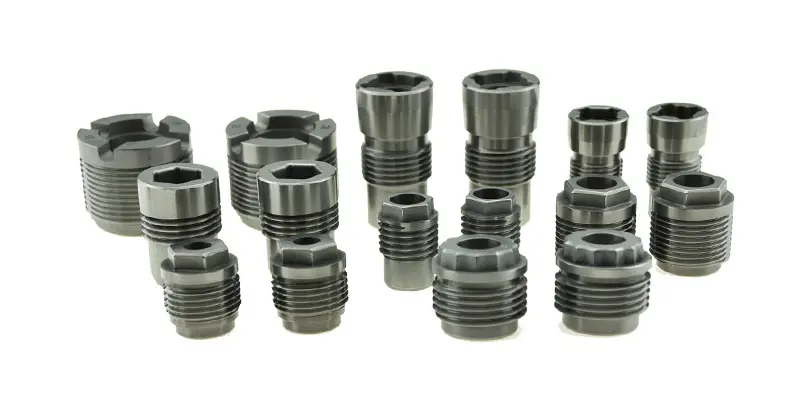Roller cone bits are essential tools in oil and gas drilling, mining, and geological exploration, with nozzle sizes playing a critical role in fluid dynamics, cutting efficiency, and bit longevity. Choosing the right nozzle size ensures optimal mud flow, rock debris removal, and heat dissipation. This article presents a comprehensive reference table of common nozzle sizes for roller cone bits, supported by application scenarios and selection guidelines.
Understanding Roller Cone Bit Nozzles

Nozzles in roller cone bits are designed to direct high-velocity drilling fluid (mud) towards the borehole face, aiding in:
- Cooling the bit and reducing wear
- Flushing cuttings away from the drilling area
- Enhancing rock fragmentation efficiency
Key parameters for nozzle sizing include:
- Orifice Diameter: Directly impacts flow rate and pressure drop
- Flow Coefficient (Cv): Measures fluid flow capacity
- Material Hardness: Determines resistance to erosion from abrasive mud
Common Nozzle Sizes and Specifications
The table below outlines the most frequently used nozzle sizes for roller cone bits, categorized by orifice diameter, flow characteristics, and typical applications:
| Nozzle Size Code | Nozzle Outer Diameter (mm) | Nozzle Assembly Length (mm) | Nozzle Outlet Diameter (mm) | Suitable Tricone Drill Bit Sizes (Inches) | Suitable Tricone Drill Bit Sizes (mm) |
|---|---|---|---|---|---|
| S0 | 18.12 | 15.96 | 6-14 | 3 1/2 – 4 | 88.9-101.6 |
| S1 | 20.3 | 17.48 | 6-14 | 4 1/8 – 5 3/4 | 104.8-146.1 |
| S2 | 23.5 | 19.05 | 6-16 | 5 7/8 – 7 3/8 | 149.2-187.3 |
| S3 | 29.74 | 20.62 | 6-22 | 7 1/2 – 8 1/4 | 190.5-209.6 |
| S4 | 32.89 | 26.97 | 6-22 | 8 3/8 – 14 5/8 | 212.7-349.3 |
| S5 | 40.84 | 26.97 | 6-22 | 14 3/4 – 26 | 374.7-914.4 |
| SC2 | 23.5 | 26 | 6-14 | 8 3/8 – 11 | 212.7-279.4 |
| SC4 | 32.89 | 35.32 | 6-22 | 11 5/8 – 17 1/2 | 395.3-914.4 |
Nozzle Series Application Breakdown
RC-100 Series: Light-Duty Drilling
Ideal for shallow wells in soft formations, the RC-100’s smaller orifice (6.35–10mm) balances fluid velocity and pressure, preventing excessive wear in low-stress conditions. Common in water well drilling and shallow oil exploration.
RC-200 Series: Medium-Duty Operations
The RC-200 series suits medium-depth drilling in shale or dolomite, with 10.5–15mm orifices providing optimal flow to clear cuttings without compromising bit stability. Widely used in onshore oil and gas fields.
RC-300 Series: Heavy-Duty Hard Rock Drilling
Engineered for hard rock formations, the RC-300’s diamond-coated WC material resists erosion from abrasive granite or basalt. Its 15.5–20mm orifices support high-pressure mud flows (1000+ psi) for efficient rock fragmentation.
RC-400 Series: Large Diameter Boreholes
Designed for 12.25+ inch bits, the RC-400’s larger orifices (20.5–25mm) handle high-volume mud flow in soft sediments, commonly used in coastal drilling or large-diameter pipeline projects.
RC-500 Series: Specialized Applications
With composite ceramic construction, the RC-500 resists chemical degradation in corrosive mud, making it suitable for deep water well drilling or geothermal projects with high-temperature fluids.
Key Factors for Nozzle Size Selection
1. Formation Hardness
- Soft Formations (sandstone): Choose smaller nozzles (RC-100, 6.35–10mm) for controlled flow.
- Hard Formations (granite): Require larger nozzles (RC-300, 15.5–20mm) for high-velocity mud to enhance rock breaking.
2. Drilling Fluid Properties
- High-viscosity mud: Larger nozzles (RC-400/500) prevent excessive pressure drop.
- Low-viscosity mud: Smaller nozzles (RC-100/200) maintain sufficient velocity for cuttings removal.
3. Bit Size and Type
- Small bits (4.5–8.5 in): Use RC-100/200 series (6.35–15mm orifices).
- Large bits (12.25+ in): Require RC-400/500 series (20.5+mm orifices) for balanced flow distribution.
4. Operational Pressure
- High-pressure systems (1500+ psi): Opt for diamond-coated nozzles (RC-300) to resist erosion.
- Low-pressure setups (500–1000 psi): Carbide or steel nozzles (RC-100/400) are cost-effective.
Maintenance Tips for Nozzle Longevity
- Regular Inspection: Check for wear, cracks, or blockages after each drilling run.
- Mud Filtration: Use high-efficiency filters to reduce abrasive particles in the fluid.
- Storage Protection: Keep nozzles in anti-corrosion sleeves to prevent rust in humid environments.
- Alignment Check: Ensure nozzles are correctly seated to avoid uneven flow and bit vibration.
Conclusion
Selecting the right nozzle size for roller cone bits is critical to optimize drilling efficiency and reduce operational costs. By matching nozzle specifications (e.g., RC-100 for soft formations, RC-300 for hard rock) to formation type, mud properties, and bit size, operators can enhance cuttings removal, extend bit life, and minimize downtime. For custom nozzle solutions or technical support, contact our drilling tool experts to find the perfect fit for your project requirements.
Post time: Jul-28-2025





